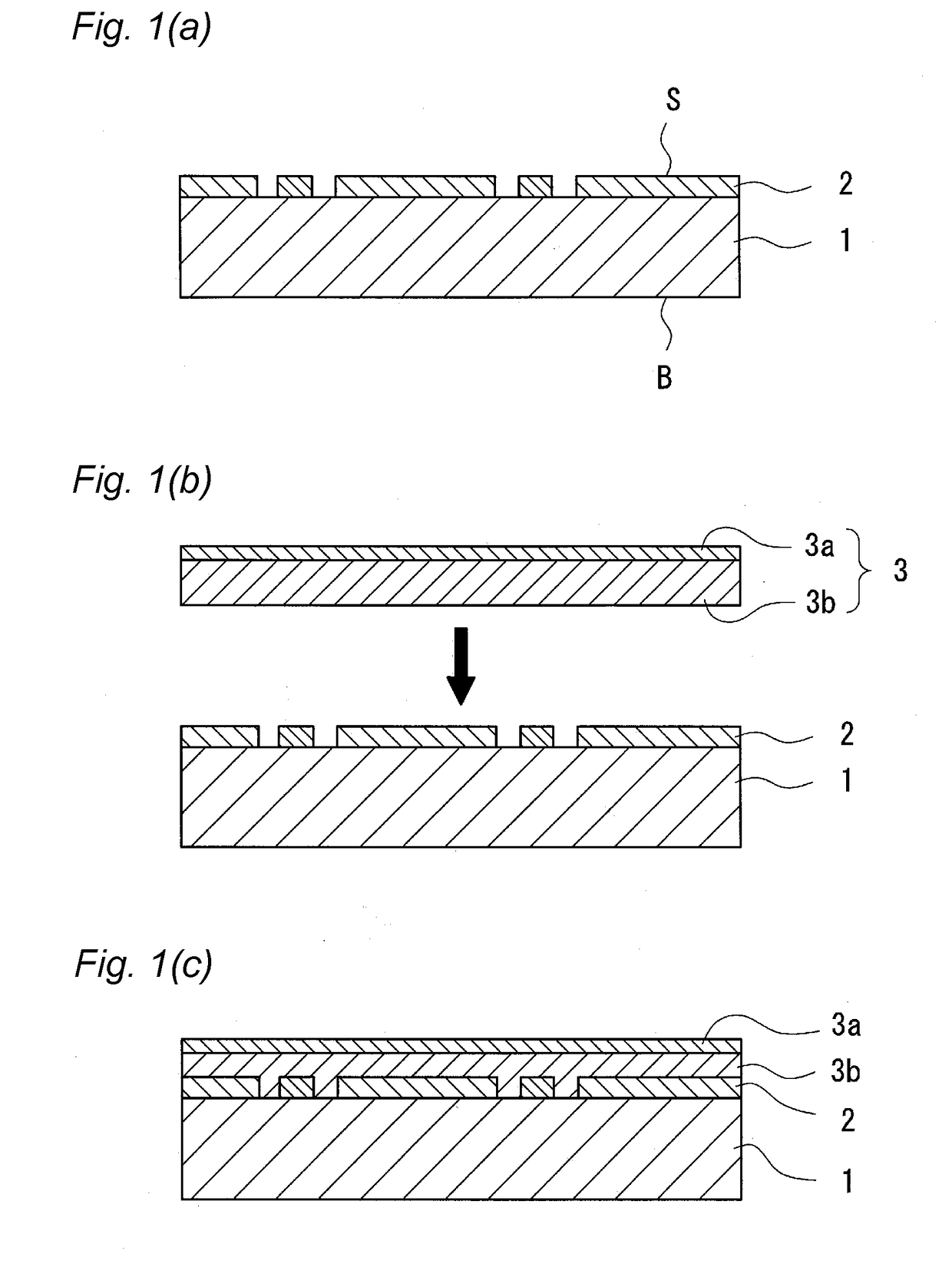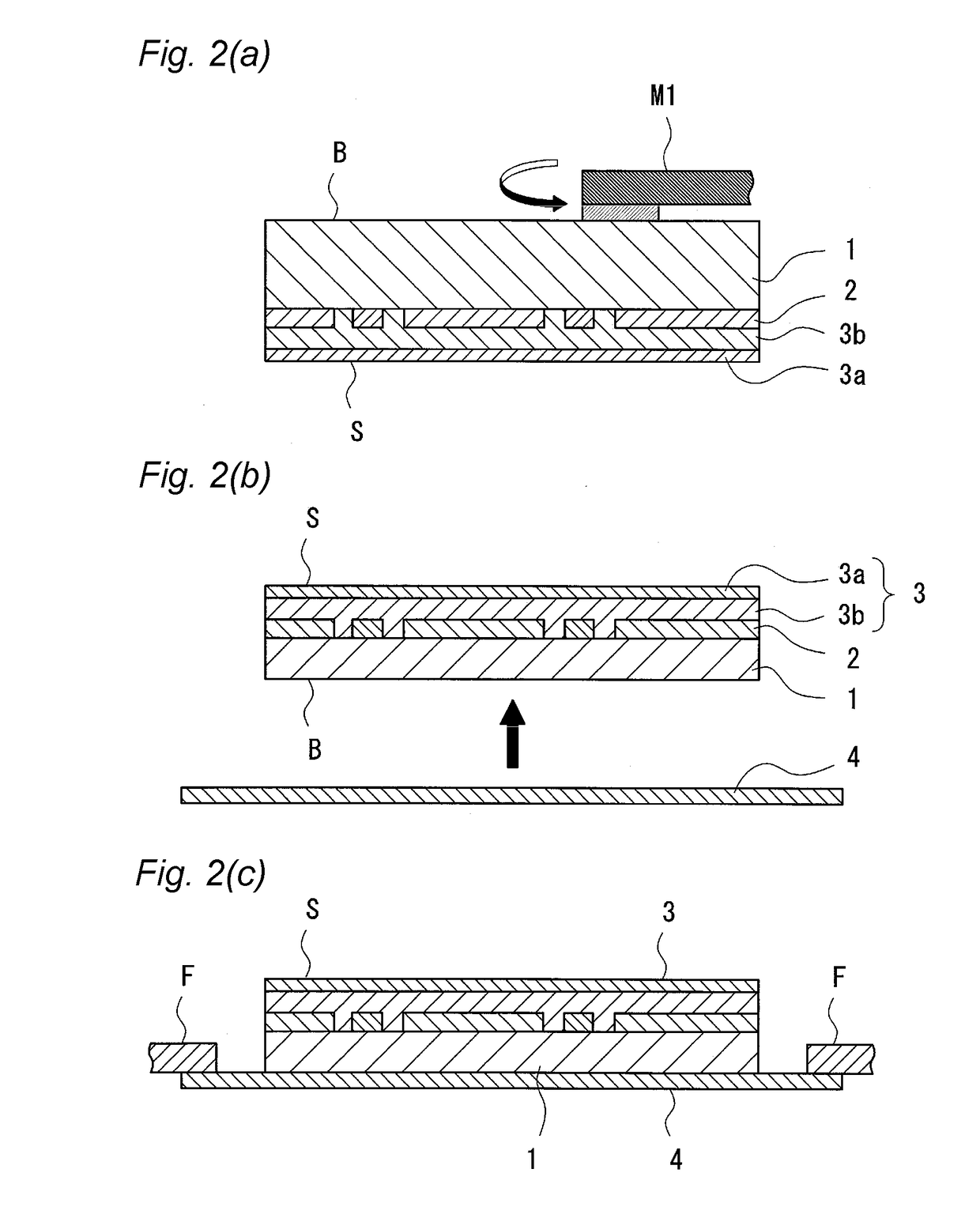Mask-integrated surface protective film
- Summary
- Abstract
- Description
- Claims
- Application Information
AI Technical Summary
Benefits of technology
Problems solved by technology
Method used
Image
Examples
example 1
[Example 1] Preparation of Mask-Integrated Surface Protective Film, and Production of Semiconductor Chip
[0108]A mask-integrated surface protective film 3 composed of a polystyrene resin (trade name: XC-515, manufactured by DIC Corporation) and an ethylene-butyl acrylate copolymer (EBA) resin (trade name: LOTRYL 30BA02, manufactured by ARKEMA K.K., ethylene content rate: 70% by weight) was prepared in the form of a film in accordance with an extrusion method so that the film thicknesses of the layers were polystyrene resin: EBA resin=90 μm: 10 μm, and the total film thickness was 100 μm. Hereinafter, the polystyrene resin layer was used as the substrate film 3a, and the EBA resin layer was used as the mask material layer 3b.
[0109]The obtained mask-integrated surface protective film was laminated on the surface of a silicon wafer (diameter: 8 inches) having thereon scribe lines using a laminator DR85001III (trade name, manufactured by Nitto Seiki Co., Ltd.). The lamination temperatur...
example 2
[Example 2] Preparation of Mask-Integrated Surface Protective Film, and Production of Semiconductor Chip
[0113]A mask-integrated surface protective film 3 composed of a polystyrene resin (trade name: XC-515, manufactured by DIC Corporation) and an ethylene-vinyl acetate copolymer (EVA) resin (trade name: ULTRATHENE 635, manufactured by Tosoh Corporation, ethylene content rate: 75% by weight) was prepared in the form of a film in accordance with an extrusion method so that the film thicknesses of the layers were polystyrene resin: EVA resin=95 μm: 5 μm, and the total film thickness was 100 μm. Hereinafter, the polystyrene resin layer was used as the substrate film 3a, and the EVA resin layer was used as the mask material layer 3b.
[0114]The obtained mask-integrated surface protective film 3 was laminated on the surface of a silicon wafer (diameter: 8 inches) having thereon scribe lines using a laminator DR85001III (trade name, manufactured by Nitto Seiki Co., Ltd.). The lamination tem...
example 3
[Example 3] Preparation of Mask-Integrated Surface Protective Film, and Production of Semiconductor Chip
[0117]A mask-integrated surface protective film 3 composed of a polystyrene resin (trade name: XC-515, manufactured by DIC Corporation) and an ethylene-vinyl acetate copolymer (EVA) resin (trade name: ULTRATHENE 750, manufactured by Tosoh Corporation, ethylene content rate: 68% by weight) was prepared in the form of a film in accordance with an extrusion method so that the film thicknesses of the layers were polystyrene resin: EVA resin=80 μm: 20 μm, and the total film thickness was 100 μm. Hereinafter, the polystyrene resin layer was used as the substrate film 3a, and the EVA resin layer was used as the mask material layer 3b.
[0118]The obtained mask-integrated surface protective film 3 was laminated on the surface of a silicon wafer (diameter: 8 inches) having thereon scribe lines using a laminator DR85001III (trade name, manufactured by Nitto Seiki Co., Ltd.). The lamination te...
PUM
| Property | Measurement | Unit |
|---|---|---|
| Temperature | aaaaa | aaaaa |
| Temperature | aaaaa | aaaaa |
| Percent by mass | aaaaa | aaaaa |
Abstract
Description
Claims
Application Information
 Login to View More
Login to View More - R&D
- Intellectual Property
- Life Sciences
- Materials
- Tech Scout
- Unparalleled Data Quality
- Higher Quality Content
- 60% Fewer Hallucinations
Browse by: Latest US Patents, China's latest patents, Technical Efficacy Thesaurus, Application Domain, Technology Topic, Popular Technical Reports.
© 2025 PatSnap. All rights reserved.Legal|Privacy policy|Modern Slavery Act Transparency Statement|Sitemap|About US| Contact US: help@patsnap.com



